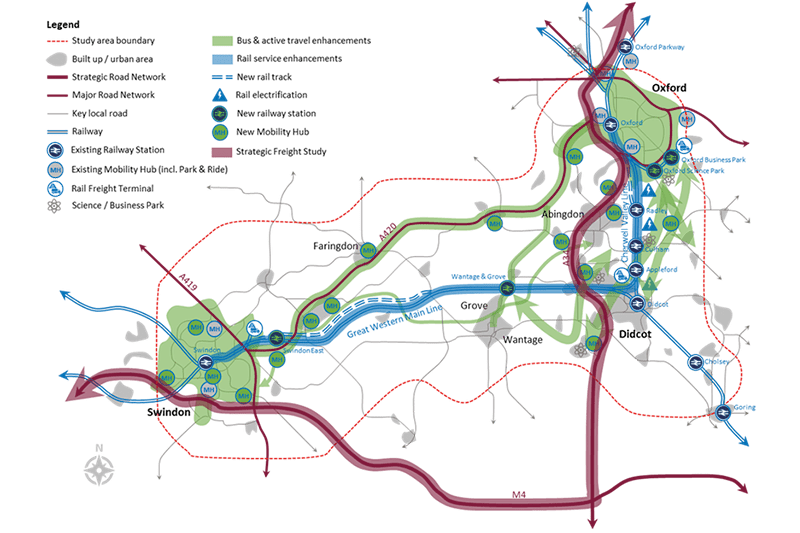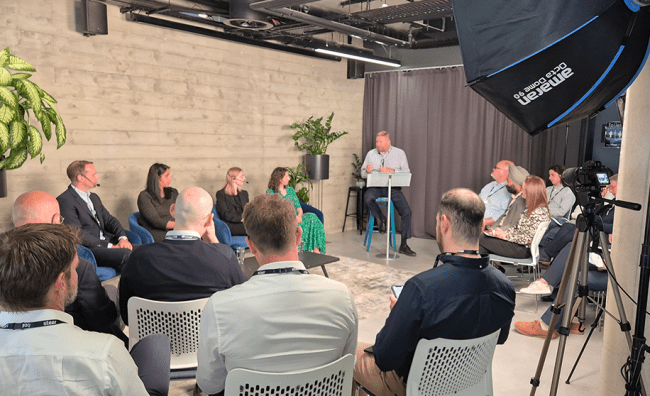Reducing regional car dependency while improving access to opportunities
The latest in a series of connectivity studies developed with England's Economic Heartland has now been published.

As part of Steer’s ongoing work with sub-national transport bodies across England, the latest in a series of connectivity studies developed with England’s Economic Heartland has now been published.
The Swindon – Didcot – Oxford Connectivity Study is the third in an ongoing programme of studies being managed by Steer to examine the region in detail to identify packages of multimodal infrastructure, service, or policy interventions to achieve EEH’s vision to support sustainable growth and improve quality of life and wellbeing through a world-class, decarbonised transport system which harnesses the region’s global expertise in technology and innovation to unlock new opportunities for residents and businesses, in a way that benefits the UK as a whole (Connecting People, Transforming Journeys, England’s Economic Heartland, 2021).
Supported by a wider project team including WSP, 5th Studio and DMS Research & Consulting, the project team worked collaboratively with EEH and their key stakeholders to develop the evidence base then identify, package interventions to improve access and connectivity; the study recommends 70 interventions to improve connectivity within and through the study area.
These are then tested and confirmed through the use of EEH’s Economy Land Use Model (EEHULUM), also developed by Steer. Compared to a business-as-usual baseline, the EEHULUM results show that if implemented in full, the recommended connectivity plan could achieve the following step change each weekday by 2050:
- 75,000 fewer journeys by private vehicles (including cars)
- 62,000 more journeys by bus
- 45,000 more trips made by walking or cycling
- 20,000 more journeys by train
By 2050, this investment could also deliver the following for the area compared to the business-as-usual baseline:
- 22,000 tonnes less CO2e emitted per year
- 3,200 additional new jobs created
- £280 million in GVA per annum
- 2,400 additional new residents
The study’s recent approval by the EEH Strategic Leadership Board was welcomed by Steven Bishop, Director with Steer, who oversees the connectivity study programme, “regional transport studies like this are vital to understanding how to most effectively improve transport connectivity within a region, and what interventions should be recommended for further development and investment.”
“We wish to thank the team at England’s Economic Heartland for the opportunity to support their work engaging with stakeholders from national infrastructure operators like Network Rail and National Highways right through to each respondent to the public Call for Evidence process.”
The following are some of the key recommendations presented in the four place-based and two theme-based packages, and which are anticipated to make a notable contribution to achieving the vision of the EEH Transport Strategy:
- Capacity improvements along the A420 corridor to support growth that will enhance this key route between Swindon and Oxford for all users through interventions such as A420 Bus Priority Measures, A420 Junction Improvements, A420 Road Safety Improvements, A420 Mobility Hubs, and Bus Improvements to S6 Service (Oxford to Swindon via Faringdon), and Encouraging Freight from A420 to Strategic Road Network.
- An enhanced S6 bus service between Oxford and Swindon with Bus Improvements to S6 Service (Oxford to Swindon via Faringdon) providing for additional vehicles and drivers to provide extended operating hours based on minimum 15-minute frequency throughout the day (currently only 15min at peak times) and increased availability of bus services in early morning, late evenings and at weekends. This would be particularly supported by A420 Bus Priority Measures and A420 Mobility Hubs.
- New passenger rail services to, from and via Oxford through the Reopening of the Cowley Branch line to passengers, including the introduction of 2tph passenger services from London to Oxford Business and Science Parks Stations, and extension of East West Rail and Birmingham/Banbury services beyond Oxford to/from Didcot, Swindon and Bristol.
- Demand management measures in key urban areas (with a focus on Oxford) through the delivery of the Oxford Traffic Filters, Workplace Parking Levy, and Zero Emissions Zone (ZEZ) combined with Bus Rapid Transit in Oxford and Oxford Local Cycling & Walking Plan (LCWIP) / Active Travel Improvements.
- Electrification and capacity improvements of the railway between Didcot and Oxford, with an increase from two to four tracks between Kennington Junction (Oxford) to Radley Junction, Cherwell Valley Line Capacity Improvements between Oxford and Didcot, Cherwell Valley Line Electrification between Oxford and Didcot, and improvements at various stations including Oxford, Didcot, Radley, Appleford, and Culham. This will enable Extension of East West Rail Services and or Birmingham/Banbury Services beyond Oxford to/from Didcot, Swindon and Bristol.
- A new railway station at Wantage and Grove on an existing four-track section of the Great Western Main Line to service the local community and integrate with nearby settlements and science parks, through interventions such as A338 Bus Priority Measures, Improved Bus Services Connecting Science Vale and New Wantage and Grove Railway Station, Improved Connectivity Between Rail and Bus Services, Rural and Inter-Urban Active Travel Improvements, and extension of East West Rail and Birmingham services beyond Oxford to/from Didcot, Swindon and Bristol.
- A new railway station and mobility hub east of Swindon on a new four-track section of the Great Western Main Line to avoid traffic congestion from planned housing developments in the area, supported in particular by A420 Junction Improvements, Extension of Great Western Main Line Dynamic Passing Loop and passenger services to/from Oxford, and Improved Connectivity Between Rail and Bus Services.
- More efficient and sustainable freight movements, through Developing Local Logistics Partnerships, Encouraging Freight from A420 to Strategic Road Network, First Mile / Last Mile Sustainable Freight Delivery, and further actions drawn from the M4 / A34 Priority Freight Route Study, and the development or safeguarding of rail freight terminals in Swindon, Appleford, and Cowley to support mode shift from road to rail.
Visit the EEH website to download the Swindon – Didcot – Oxford Connectivity Study Final Report

























